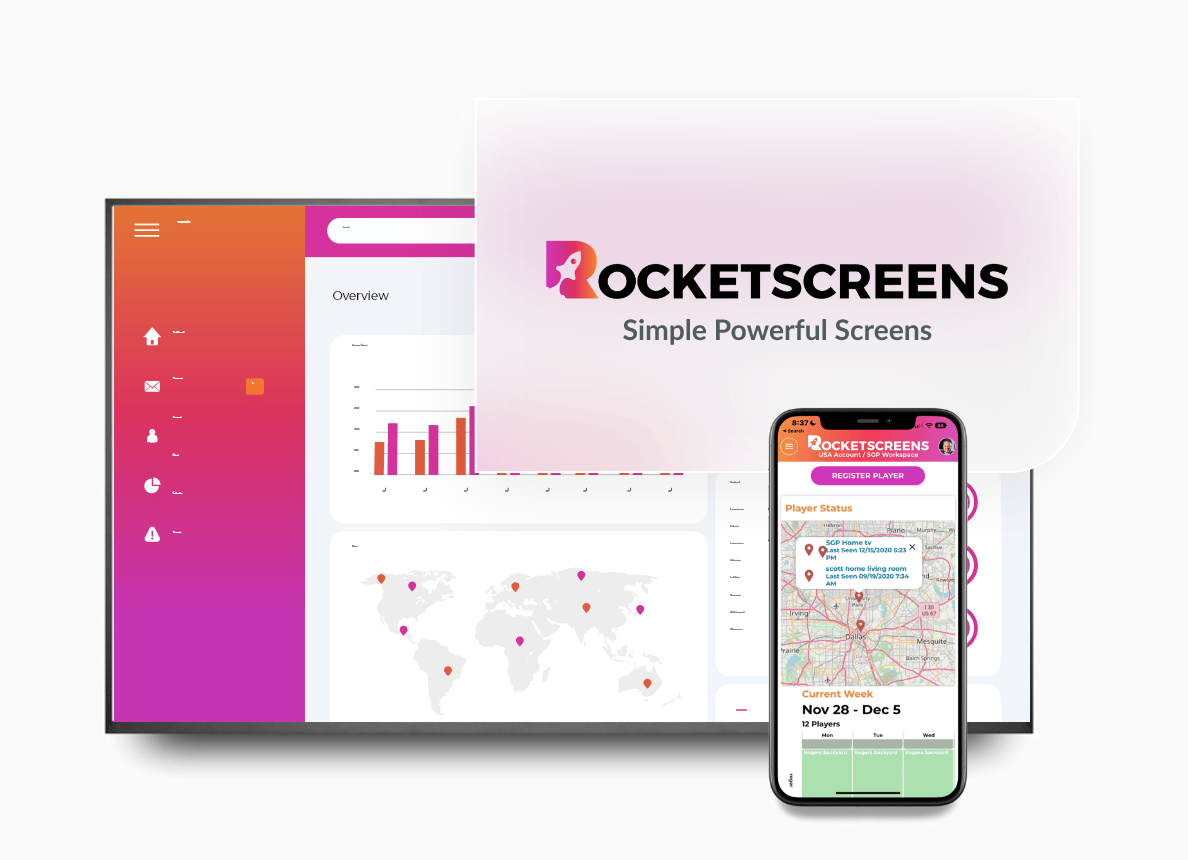
Digital dashboards provide organizations with a quick look at key performance indicators and business insights. When these dashboards are presented on TV screens, they can power decision-making in common areas such as meeting rooms, operations centers, or public spaces. However, deploying Power BI TV dashboards is not without its challenges. Many companies fall into predictable traps that reduce the effectiveness of their visual displays. Below, we explore seven common pitfalls encountered during dashboard implementation and offer practical advice to overcome these issues.
1. Information Overload: Too Much Data on Display
One of the most frequent issues faced during dashboard deployment is the tendency to cram too much information into a single display. When dashboards become overly complex, decision-makers can miss critical insights because the presentation lacks clear focus.
Why This Occurs
- Excessive Metrics: Including every possible data point in one view leads to confusion rather than clarity.
- Visual Clutter: Overuse of colors, fonts, and chart types can disrupt the viewer’s ability to parse the data.
- Poor Hierarchy: Without a clear order of importance, viewers struggle to prioritize key metrics over secondary details.
What to Do Instead
- Focus on Key Indicators: Identify a handful of metrics that truly reflect your performance goals. Display these prominently to ensure immediate recognition.
- Use White Space Effectively: A clean layout with enough breathing room helps guide attention to important areas.
- Group Related Data: Organize metrics into logical clusters so that related figures are displayed together.
By streamlining content and emphasizing clarity, you prevent common power bi dashboard mistakes that lead to information overload. A simple, well-organized display supports effective decision-making and minimizes tv display errors.
2. Technical Setup Errors: Misconfigurations and Integration Hurdles
Technical issues are common during the setup of Power BI dashboards for TV displays. These errors can range from connectivity issues to integration conflicts between different systems and data sources.
Common Technical Issues
- Network Connectivity: Unstable connections can cause delays in updating data or render screens blank.
- Hardware Incompatibility: Incompatible display devices or cables can lead to poor resolution and display errors.
- Software Misconfiguration: Incorrect settings in Power BI or on the digital signage platform may result in misaligned data or failure to update.
How to Address Technical Setup Errors
- Thorough Testing: Before going live, run extensive tests under different conditions to ensure all components interact as expected.
- Use Trusted Integration Platforms: Platforms like RocketScreens simplify the process by connecting securely to over 100 applications. Their built-in integration with Power BI minimizes common setup errors.
- Clear Documentation: Maintain detailed documentation of your technical setup. This helps in troubleshooting and ensures consistency when replicating the setup in new locations.
- Regular Maintenance: Schedule periodic checks to verify that all hardware and software components are functioning properly.
Addressing technical setup errors early can prevent a host of dashboard implementation problems. By ensuring that your Power BI dashboards are configured correctly, you maintain data integrity and reduce the risk of tv display errors.
3. Update Frequency Problems: Striking the Right Balance
Dashboards need to reflect real-time data to be useful, but updating them too frequently or too infrequently can cause issues.
The Risks of Improper Update Frequency
- Overly Frequent Updates: When data refreshes too rapidly, the audience may struggle to absorb information before it changes. This constant flux can lead to misinterpretation and hesitation in decision-making.
- Infrequent Updates: Conversely, dashboards that update rarely might show outdated data, leading to decisions based on old information.
Best Practices for Update Frequency
- Determine Your Audience Needs: Consider how often your audience needs the latest data. For high-paced environments, more frequent updates might be necessary, while slower-moving sectors might prefer less frequent changes.
- Set a Fixed Schedule: Use a regular interval that matches the pace of your business. For example, if operations are tracked in near real-time, a 5- to 10-minute update interval might be ideal.
- Monitor Performance: Keep an eye on how updates affect system performance. Adjust intervals if you notice delays or if the system appears overloaded.
- Automated Alerts: Implement automated alerts for when updates fail. This proactive measure can prevent prolonged display of outdated information.
By finding the right balance in update frequency, you avoid common business intelligence pitfalls that can render your Power BI dashboards less effective. Proper scheduling ensures that viewers receive information that is both timely and actionable.
4. Display Location Mistakes: Poor Placement Reducing Impact
Even the best-designed dashboard can fail if the display is positioned in an area with limited visibility or poor environmental conditions. Display location is crucial to ensure that the intended audience sees and benefits from the information.
Factors Contributing to Display Location Mistakes
- Inadequate Visibility: Placing a screen where it is not easily seen by key decision-makers results in wasted investment.
- Environmental Distractions: Locations with high ambient light or constant movement can reduce screen readability.
- Incorrect Viewing Angles: Displays that are too high, too low, or placed at awkward angles can diminish the effectiveness of the dashboard.
Tips for Optimal Display Location
- Choose High-Traffic Areas: Place dashboards in areas where they are likely to catch the eye of employees and visitors alike. Common choices include lobbies, meeting rooms, and central corridors.
- Assess Lighting Conditions: Ensure the screen is installed in an area with controlled lighting to avoid glare. Consider using screens with anti-glare properties if needed.
- Plan for Accessibility: The screen should be positioned so that it can be easily viewed from multiple angles without the need for excessive movement.
- Test Before Final Installation: Use temporary setups to gauge the best location for permanent installation. Solicit feedback from users about the screen’s visibility and clarity.
Avoiding display location mistakes can significantly reduce tv display errors and ensure that your Power BI dashboards effectively reach their intended audience.
5. Poor KPI Selection: The Importance of Choosing the Right Metrics
Choosing the wrong key performance indicators (KPIs) can mislead your team and lead to misguided decisions. It is essential to select metrics that align with your organizational goals and accurately reflect performance.
Why KPI Selection Matters
- Irrelevant Metrics: Displaying metrics that do not directly influence business outcomes creates noise rather than useful insight.
- Overemphasis on Quantity Over Quality: More data does not necessarily mean better insights. It is better to focus on a few, critical KPIs than on a multitude of less significant numbers.
- Misalignment with Objectives: KPIs must be directly linked to the business goals they are intended to measure. Failing to do so can lead to dashboard implementation problems where the displayed data does not drive strategic decisions.
Strategies for Effective KPI Selection
- Engage Stakeholders: Involve key team members in the process of choosing KPIs to ensure the metrics reflect collective priorities.
- Benchmark Performance: Use historical data to determine which metrics have the strongest correlation with success.
- Test and Refine: Start with a basic set of KPIs and adjust as you gather feedback on their effectiveness. Flexibility allows you to refine the dashboard over time.
- Keep it Simple: A clear, concise set of metrics is more actionable than a complex, cluttered view. Prioritize the information that is truly essential for performance tracking.
Selecting the right KPIs is critical to avoiding common power bi dashboard mistakes. A focused approach can steer clear of business intelligence pitfalls and provide a reliable snapshot of organizational performance.
Read - How to Display Power BI on a TV Screen
6. Inadequate Testing and Feedback: The Need for a Real-World Trial
Deploying a Power BI dashboard without sufficient testing is a recipe for failure. Without real-world validation, even a well-planned dashboard can result in errors that affect user experience.
Testing Pitfalls
- Simulated Environments Only: Relying solely on lab tests or simulations does not account for the nuances of real-world usage.
- Lack of User Input: Failing to collect feedback from end users means missing out on valuable insights that could improve the dashboard.
- No Contingency Plans: Without a fallback strategy, unexpected issues may go unaddressed, leading to prolonged periods of downtime or incorrect data displays.
Best Practices for Testing and Feedback
- Pilot Programs: Implement a pilot phase in a controlled environment where a small group of users can test the dashboard in a real-world setting. Their insights can reveal issues that might not appear during internal testing.
- Collect Diverse Feedback: Seek input from various stakeholders, including technical staff, managers, and front-line employees. A well-rounded perspective can help identify and resolve a broad range of issues.
- Iterative Improvements: Use the feedback to make gradual improvements rather than overhauling the system entirely. This approach helps in mitigating risks and ensures steady progress.
- Monitor System Performance: After the dashboard goes live, continuously monitor its performance. Set up alerts for anomalies and conduct periodic reviews to ensure everything runs smoothly.
By incorporating thorough testing and welcoming constructive feedback, you can resolve many dashboard implementation problems before they escalate. This proactive approach is essential to prevent long-term setbacks.
7. Security and Data Privacy Oversights: Protecting Sensitive Information
Security is a significant concern when deploying any digital system, including Power BI dashboards. Overlooking security measures can expose your organization to data breaches and unauthorized access, which in turn can damage trust and disrupt operations.
Potential Security Issues
- Weak Access Controls: If access to the dashboard is not restricted to authorized personnel, sensitive data might be at risk.
- Inadequate Data Encryption: Data transmitted between Power BI and display systems must be encrypted to prevent interception.
- Failure to Update Security Protocols: As cyber threats evolve, outdated security measures can leave your system vulnerable.
Recommendations for a Secure Dashboard
- Implement Strong Authentication: Use multi-factor authentication and strict password policies to ensure that only authorized users can access the dashboard.
- Encrypt Data End-to-End: Ensure that all data transfers are protected by encryption, reducing the risk of unauthorized access during transmission.
- Regular Security Audits: Periodically review security measures and update them to match current best practices. This continuous improvement cycle helps to catch vulnerabilities before they are exploited.
- Leverage Secure Platforms: Consider using a platform like RocketScreens, which is designed to securely integrate with over 100 applications. Such platforms provide an additional layer of security and reliability, helping to prevent many common tv display errors and dashboard implementation problems.
By addressing security and data privacy early in the planning process, you minimize the risk of breaches and maintain the trust of your stakeholders.
Recommendations for a Successful Dashboard Rollout
Achieving success with Power BI TV dashboards involves careful planning, regular maintenance, and a focus on user experience. Here are some actionable steps to ensure your dashboard is effective:
- Define Clear Objectives: Start by outlining the specific business outcomes you wish to influence. This clarity will guide your KPI selection and overall design.
- Invest in Training: Equip your team with the necessary skills to manage and interpret dashboard data. Training reduces the likelihood of misinterpretation and promotes more informed decision-making.
- Monitor and Adapt: Track the dashboard’s performance continuously and be prepared to make adjustments based on feedback and changing business conditions.
- Utilize Proven Platforms: Integrate your Power BI dashboards with reliable solutions like RocketScreens. Their secure, streamlined integration with multiple applications can simplify the process and reduce common technical issues.
These strategies help bridge the gap between concept and execution, ensuring that your digital signage effectively supports your business intelligence efforts.
How RocketScreens Can Help
RocketScreens offers a straightforward digital signage platform that reduces many of the common mistakes associated with Power BI dashboard implementations. Here’s why it stands out:
- Secure Integration: RocketScreens connects seamlessly with more than 100 applications. This reliable integration minimizes technical setup errors and ensures that your dashboards update as expected.
- User-Friendly Interface: The platform’s design focuses on clarity and ease of use. This simplicity aids in reducing information overload, ensuring that only essential data is presented to your audience.
- Strategic Display Options: RocketScreens helps you determine optimal display locations. Its design tools allow for flexible adjustments, ensuring that your dashboards are visible and effective wherever they are placed.
- Proactive Monitoring: The platform includes tools that notify you if any update frequency problems or technical issues arise. This real-time feedback mechanism prevents prolonged dashboard implementation problems.
- Focus on Security: RocketScreens incorporates modern security measures to protect your data, reducing the risk of unauthorized access and ensuring that your business intelligence remains confidential.
Using a dedicated digital signage solution like RocketScreens can greatly reduce the common pitfalls that many organizations face when deploying Power BI TV dashboards.
Final Thoughts
Successful implementation of Power BI TV dashboards hinges on avoiding common mistakes. By addressing information overload, technical setup errors, update frequency challenges, and display location issues, you create a more effective tool for communicating business insights. Each of the seven mistakes outlined here represents a critical area where attention to detail can significantly improve the final result.
Organizations that prioritize simplicity in design, rigorous testing, and strong security protocols are better positioned to harness the benefits of digital signage. Whether you are tracking performance in a busy operations center or displaying key metrics in a common area, clear and actionable information is key. Overcoming these hurdles leads to improved decision-making and stronger overall performance.
For teams seeking a hassle-free setup, leveraging platforms like RocketScreens not only streamlines integration but also offers ongoing support to prevent common power bi dashboard mistakes. By selecting the right metrics, testing extensively, and ensuring optimal display conditions, your dashboards can avoid the pitfalls that frequently undermine their potential.
Implementing these strategies will contribute to a well-functioning dashboard that delivers the right message at the right time. Regular reviews and iterative improvements keep the system aligned with business objectives. A commitment to these best practices turns digital signage from a simple display into a valuable strategic asset for your organization.
A Checklist to Avoid Common Mistakes
- Keep It Focused:
- Limit metrics to the most relevant indicators.
- Group related data logically.
- Ensure Technical Readiness:
- Test network connections and hardware compatibility.
- Use platforms designed for secure integrations.
- Balance Update Frequency:
- Define a refresh schedule that suits your operational pace.
- Monitor performance and adjust as necessary.
- Select Prime Locations:
- Choose high-traffic areas with controlled lighting.
- Test screen visibility from various angles.
- Choose Relevant KPIs:
- Collaborate with stakeholders for metric selection.
- Prioritize quality over quantity.
- Test Thoroughly:
- Run pilot programs and collect diverse user feedback.
- Maintain documentation and contingency plans.
- Prioritize Security:
- Implement strong authentication and encryption.
- Schedule regular security audits.
This checklist serves as a guide to prevent dashboard implementation problems and reduce business intelligence pitfalls. Each point ensures that the dashboard remains a useful tool rather than a source of confusion.
By carefully considering each of these seven areas, organizations can avoid many of the common pitfalls that plague Power BI TV dashboards. Whether it’s ensuring clarity to prevent information overload, addressing technical setup errors, or choosing the right display location, attention to these details results in a more effective and reliable dashboard.
Investing time in planning and testing will yield dividends in terms of improved communication and decision-making.
With a well-designed system in place, the dashboard becomes a trusted resource for everyone in the organization. The guidance provided here should serve as a roadmap for both initial setup and ongoing management, helping you steer clear of common mistakes and achieve smoother implementation.
Adopting a holistic approach that includes thoughtful design, regular feedback, and a secure technical framework allows your organization to benefit fully from its investment in digital dashboards. By steering clear of these seven common mistakes, you set the stage for better data visualization and more informed business decisions.
For organizations looking to simplify the process further, platforms like RocketScreens are available to bridge the gap between data and display. Their comprehensive solution addresses many of the challenges discussed above, making it easier for your team to focus on strategic initiatives rather than technical troubleshooting.
By following the strategies outlined here, you are well-prepared to tackle the common pitfalls of deploying Power BI TV dashboards. With clear goals, careful planning, and the right tools at your disposal, your organization can sidestep these issues and create displays that truly support your business insights.





